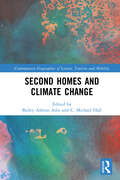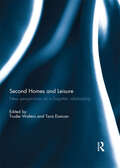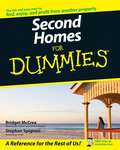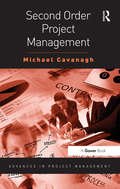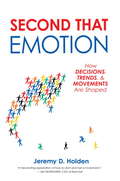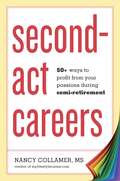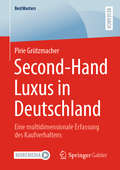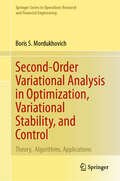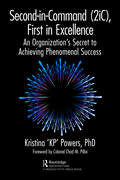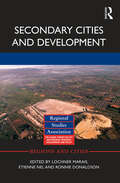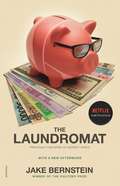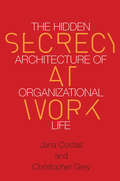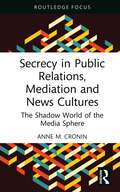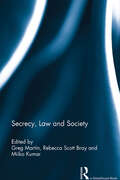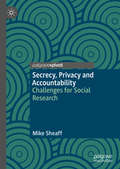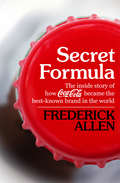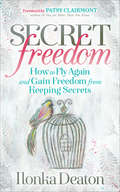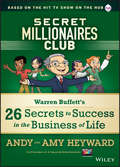- Table View
- List View
Second Chance: for Your Money, Your Life and Our World
by Robert T. KiyosakiFew would argue with the fact that, on many fronts, we are a world in crisis. And there are two sides to every crisis, be it a leadership crisis, an economic crisis, an education crisis or a moral crisis. The two side to crisis are danger and opportunity.Robert Kiyosaki's new book, Second Chance...for Your Money and Your Life, uses the lessons from the past and a brutal assessment of the present to prepare readers to see--and seize--the future.If readers can train their minds to see what their eyes cannot, in a world that is becoming increasingly more 'invisible' and moving at a high rate of speed, they can have a second chance at creating the life they've always wanted.The global problems we face cannot be solved by the same minds and people who created them and today's world demands the ability to see the future and prepare for what lies ahead...prepare for the opportunities as well as the challenges.Like it or not, we are all involved in the greatest evolutionary event in human history. The Industrial Age is over and the Information Age continues to accelerate. The visible agents of change have become invisible...and harder to see. And the future belongs to those who can train their minds, use the past to see the future, and take the steps to create the positive change they want to see in their lives.Second Chance is a guide to understanding how the past will shape the future and how you can use Information Age tools and insights to create a fresh start. This book is a guide to facing head-on the dangers of the crises around us-and steps and tips for seizing the opportunities they present.
Second Harvest Heartland: Ending Hunger Together
by V. Kasturi Rangan Courtney HanIn March 2020, Second Harvest Heartland, one of six Foodbanks serving Minnesota, was caught in the COVID-19 emergency with considerably more people exposed to hunger and food insecurity. Its management team led by CEO Allison O' Toole and COO Theirry Ibri alertly managed the crisis by improvising and implementing new programs. In August 2021, with signs of the crisis behind them, they had to decide which of the adaptations they should keep, and how to go back to addressing their original mission of ending hunger.
Second Homes and Climate Change (Contemporary Geographies of Leisure, Tourism and Mobility)
by C. Michael Hall Bailey Ashton AdieThis book is the first to address the important interrelationship between second homes and climate change, which has become an increasingly relevant issue for many regions around the world. Second homes are often a key source of tourist visitation as well as economic benefit for their host communities. The chapters provide an array of international case studies and climate change impacts, including the changing biocultural landscapes in Italy, hazard risks in the mountains of Poland, and the shifting media discussion on second homes and climate change in Finland. Topics covered focus on issues around planning and governance in second home locations, adaptation and mitigation measures implemented by second home owners, and the influence of second home owners’ place attachment in relation to second home impacts. It introduces the overall topic of second homes and climate change while also laying the groundwork for future work in this burgeoning area of research. This book will be of significant interest to upper-level undergraduates, graduate students, and academics in the fields of geography, tourism, planning, housing studies, regional development, environmental management, and disaster management. It would also be of use for professionals who engage with second home communities, particularly planners, government officials, and environmental officers.
Second Homes and Leisure: New perspectives on a forgotten relationship
by Trudie Walters and Tara DuncanSecond homes (variously summer houses, shacks, baches, cottages, dacha) are a popular cultural phenomenon in many countries and an emerging trend in others. They are inextricably linked to tourism, recreation and leisure, and yet the fundamental relationship between second homes and leisure often appears to have been overlooked by researchers in the area. This book seeks to address this absence, bringing together an exciting collection of research from around the world. Drawing on examples from Canada, Japan, Morocco, Costa Rica, New Zealand and the United Kingdom, this book highlights the interdisciplinary nature of second home research in the leisure field. The book describes the nexus of second homes and leisure from a variety of perspectives: planning and policy, historical, social and cultural. It is an essential work for those interested in new cultural viewpoints on second homes and leisure practices. This book was originally published as a special issue of Annals of Leisure Research.
Second Homes for Dummies
by Stephen Spignesi Bridget MccreaThinking about owning a second home? Whether you want a relaxing getaway spot, a future retirement home, or just a place to rent out for profit, having a second home has always been a good investment. But how will you know where to look, how to invest, and what you need to avoid? Second Homes For Dummies gives you the tools you need to handle the entire second-home buying process from concept to completion! This book covers the bases and the basics of buying a second home, presenting all information in a logical and modular format so you can find just what you need on the subjects that interest you. You'll find out everything you need to know to: Determine whether or not a second home is right for you Maximize your options for a second home Search for a home and find the money to pay for it Rent out your home for profit Renovate and maintain it to ensure its growing value Make your second home your primary home Look for and purchase a home in another country Also provided are a list of the best places in the world to buy a home, ways to improve your home and make it first rate, and rules that you should talk about with your guests. With Second Homes For Dummies, you can make your dream of having a second home come true!
Second Order Project Management (Advances in Project Management)
by Michael CavanaghIf you do what you've always done, you'll get what you've always got, and if it's not good enough, you need to do something else. As project complexity increases, so too does the need to do new things. The existing Project Management tools - examples being Earned Value Management, PRINCE2, Lifecycle Management, PMBOK® - are incredibly useful; but they were designed for linear project development in a stable, understood environment. We term them 'First Order'. Second Order Project Management (PM) goes beyond, addressing the issues of a complex, unstable, uncertain environment with all its associated difficulties. Second Order PM has to address four major issues: the conspiracy of optimism, inappropriate contracting models, the application of methods and tools capable of dealing with complexity, and the need for creative, inspirational, adhocratic leadership. These problems are compounded by the need to convince executive sponsors from different disciplines to invest in the necessary process improvement - this book is designed to help alleviate the frustration that every member of the profession has experienced when trying to gain such approval. Illustrated by interviews with an international group of very senior managers responsible for managing highly complex projects, Michael Cavanagh explains why there is nothing magical, or even complicated, about Second Order PM. The techniques discussed include aspects of System Thinking, Experiential Learning and its application, Ethics and Governance, Stakeholder Relationships, Appropriate Contracting Models, Outcome-driven Management and Leadership Behaviour, all recognised as increasingly necessary in direct proportion to the complexity of the project at hand.
Second That Emotion
by Jeremy D. HoldenFor businesspeople who want to see their company or brand break through, this book is both essential and entertaining reading. For the rest of us, the author provides a window into our decision-making processes, and how emotion-based illogical leaps drive our support for movements, whether they are political, commercial, or related to popular culture. Why do more than 30 percent of Americans believe President Obama is a Muslim? Why do most fans who supported Dove®'s "campaign for real beauty" feel comfortable ignoring the fact that the brand's parent company, Unilever, was also behind the Axe® campaign, a brand that has blatantly stereotyped women? Why is Yoko Ono still held responsible for the breakup of the Beatles? These and other random, yet related, questions are explained in here. An advertising and communications expert traces the fascinating process whereby a passion for an idea, a politician, a celebrity, or a brand gives rise to a set of illogical beliefs that becomes the basis for a powerful movement. Conventional wisdom has it that spin doctors and Madison Avenue are responsible for manipulating our thoughts, causing us to endorse ideas or buy products that we would otherwise reject outright. Holden shows that while advertising and propaganda can provide a spark and social media provides the kindling, individuals create consumer, political, and cultural trends based, more often than not, on thinking that they know logically to be flawed.
Second Thoughts on Going Public
by Richard SalomonIn 1961, Richard Salomon, the sole owner of Charles of the Ritz, decided to issue public shares in his company. The perceived advantages were the possibility of diversification, establishment of value for estate and inheritance taxes, availability of equity, personal satisfaction, liquidity, and the ability to retain control of the business. When the shares were offered, disadvantages became apparent. Closely knit executives began jockeying for positions and personal relations became strained. Short-term results became a priority over long-range planning. Stockholders were primarily interested in share value, expressing opposition to ventures that jeopardized short-term profit for the sake of long-term growth.
Second-Act Careers: 50+ Ways to Profit from Your Passions During Semi-Retirement
by Nancy CollamerA career guide that rethinks the golden years, this handbook offers 50+ income models for creating flexible, fulfilling, and profitable work during the encore stage of one's career.RETHINK YOUR RETIREMENT For many people, retirement is no longer a trifecta of golf, grandkids, and gardening-- it's an opportunity for new pursuits that involve both earning income and exploring personal passions. If you're planning for retirement or already at "retirement age" but want to continue working--whether to supplement your income or to stay mentally and physically active--veteran career coach Nancy Collamer shows how to identify your favorite interests and expertise and repackage them into more than fifty ways to earn income. These second acts range from the traditional (part-time employment, consulting) to newer Internet-based options (teaching online, writing a blog). With a prescriptive approach to securing second-act careers that are flexible, fulfilling, and fun, this book offers a wide variety of income-generating examples as well as exercises to clarify your lifestyle goals and help you plan for your next move. Second-Act Careers shows how to create a profitable and meaningful semi-retirement on your own terms and in your own way.
Second-Hand Luxus in Deutschland: Eine multidimensionale Erfassung des Kaufverhaltens (BestMasters)
by Pirie GrützmacherJeder zehnte persönliche Luxusartikel wird mittlerweile gebraucht gekauft. Dennoch sind Untersuchungen in diesem Segment bislang rar. Pirie Grützmacher untersucht anhand einer Befragung unter 418 Käufern von gebrauchten persönlichen Luxusartikeln erstmals das Kaufverhalten im High End Second-Hand-Segment in Deutschland. Dabei wird ein breites Spektrum der konsumrelevanten Entscheidungsprozesse in der Vorkauf-, Kauf- und Konsum-/Nachkaufphase dargestellt. Auch mögliche geschlechts- und altersgruppenspezifische Unterschiede werden untersucht. Die Ergebnisse der Studie weisen auf ein enormes Wachstumspotential des High End Second-Hand Segments hin. Dies korrespondiert mit einer sich fundamental wandelnden Haltung der Luxuskunden. So zeigt die Studie dynamische Veränderungen auf, die den gesamten Luxusmarkt beeinflussen können.
Second-Order Variational Analysis in Optimization, Variational Stability, and Control: Theory, Algorithms, Applications (Springer Series in Operations Research and Financial Engineering)
by Boris S. MordukhovichThis fundamental work is a sequel to monographs by the same author: Variational Analysis and Applications (2018) and the two Grundlehren volumes Variational Analysis and Generalized Differentiation: I Basic Theory, II Applications (2006). This present book is the first entirely devoted to second-order variational analysis with numerical algorithms and applications to practical models. It covers a wide range of topics including theoretical, numerical, and implementations that will interest researchers in analysis, applied mathematics, mathematical economics, engineering, and optimization. Inclusion of a variety of exercises and commentaries in each chapter allows the book to be used effectively in a course on this subject. This area has been well recognized as an important and rapidly developing area of nonlinear analysis and optimization with numerous applications. Consisting of 9 interrelated chapters, the book is self-contained with the inclusion of some preliminaries in Chapter 1.Results presented are useful tools for characterizations of fundamental notions of variational stability of solutions for diverse classes of problems in optimization and optimal control, the study of variational convexity of extended-real-valued functions and their specifications and variational sufficiency in optimization. Explicit calculations and important applications of second-order subdifferentials associated with the achieved characterizations of variational stability and related concepts, to the design and justification of second-order numerical algorithms for solving various classes of optimization problems, nonsmooth equations, and subgradient systems, are included. Generalized Newtonian algorithms are presented that show local and global convergence with linear, superlinear, and quadratic convergence rates. Algorithms are implemented to address interesting practical problems from the fields of machine learning, statistics, imaging, and other areas.
Second-Wave Millennials: Tapping the Potential of America's Youth
by Warren WrightAuthor Warren Wright takes you on an engaging journey through the generations in the workplace, starting with “Dave” the Boomer, and ending with the newest kid on the block—“Samanthe”, a Second-Wave Millennial. Page-turning narrative peppered with practical solutions tells the compelling story of how different generations can get along in the workplace—with an emphasis on tapping the potential of the newest generation—Second-Wave Millennials. Second-Wave Millennials reveals: 5 ways to craft an ideal workplace for all generations 4 lifestyle themes that make up Millennials’ identity The top soft skills required for the newly-hired Second-WaveMillennials
Second-in-Command (2iC), First in Excellence: An Organization's Secret to Achieving Phenomenal Success
by Kristina 'KP' Powers, PhDWhy do some departments, divisions, and organizations soar while others struggle? Watching another team achieve the success you feel yours more rightfully deserves can be incredibly frustrating. However, they might have something you don’t: Seconds-in-Command. Given how many Seconds-in-Command exist in the workforce, it is stunning that there are so few books about them. Organizations can and often do have more than one 2iC; large ones may have hundreds. KP Powers focuses on essential skills that individuals in these positions already possess and can enhance to become an organization’s key to achieving phenomenal success. This book introduces the groundbreaking concept of linking multiple 2iCs to form a Second-in-Command chain. This game-changing technique increases the positive impact that 2iCs can have on organizational and leader success. In today’s world, leaders no longer have the luxury of hiring more people to keep up with a growing workload. The labor shortage and the need to cut costs because of looming economic issues make that impractical. It makes more sense to consider a new organizational framework that includes 2iCs, thus multiplying existing team members’ contributions. This is especially critical in highly regulated fields such as higher education, finance, and health care, where the stakes and penalties are high and unforgiving. Second-in-Command, First in Excellence invites readers to think differently about this critical role. Geared toward leaders who have or want a 2iC as well as 2iCs themselves, this book both demonstrates the value of the 2iC position and serves as a tool for professional development.
Secondary Cities and Development (Regions and Cities)
by Lochner Marais, Etienne Nel and Ronnie DonaldsonThe role secondary cities play in the global space economy and national urban hierarchies is increasingly receiving attention from scholars and international agencies, most notably the Cities Alliance. Secondary Cities and Development considers the role of secondary cities through the lens of South Africa, a middle-income country with characteristics of both the developed and developing worlds. This book brings together a broad overview of international literature on secondary cities in South Africa and mirrors them against global experience. Chapters emphasize the importance of secondary cities as regional services areas, their potential roles in rural development, the vulnerabilities to which they are prone and their signifcant potential. By means of review, six South African case studies, and an assessment of contemporary policy approaches towards these cities, this unique volume provides insight into a spectrum of globally significant challenges. This book would be of interest to academics and policy makers working in urban studies or regional development.
Secrecy World: Inside the Panama Papers Investigation of Illicit Money Networks and the Global Elite
by Jake BernsteinA two-time Pulitzer Prize-winning journalist takes us inside the world revealed by the Panama Papers, a landscape of illicit money, political corruption, and fraud on a global scale. A hidden circulatory system flows beneath the surface of global finance, carrying trillions of dollars from drug trafficking, tax evasion, bribery, and other illegal enterprises. This network masks the identities of the individuals who benefit from these activities, aided by bankers, lawyers, and auditors who get paid to look the other way. In Secrecy World, the Pulitzer Prize winning investigative reporter Jake Bernstein explores this shadow economy and how it evolved, drawing on millions of leaked documents from the files of the Panamanian law firm Mossack Fonseca—a trove now known as the Panama Papers—as well as other journalistic and government investigations. Bernstein shows how shell companies operate, how they allow the superwealthy and celebrities to escape taxes, and how they provide cover for illicit activities on a massive scale by crime bosses and corrupt politicians across the globe.Bernstein traveled to the Caribbean, Latin America, Europe, and within the United States to uncover how these strands fit together—who is involved, how they operate, and the real-world impact. He recounts how Mossack Fonseca was exposed and what lies ahead for the corporations, banks, law firms, individuals, and governments that are implicated.Secrecy World offers a disturbing and sobering view of how the world really works and raises critical questions about financial and legal institutions we may once have trusted.
Secrecy at Work: The Hidden Architecture of Organizational Life
by Christopher Grey Jana CostasSecrecy is endemic within organizations, woven into the fabric of our lives at work. Yet, until now, we've had an all-too-limited understanding of this powerful organizational force. Secrecy is a part of work, and keeping secrets is a form of work. But also, secrecy creates a social order--a hidden architecture within our organizations. Drawing on previously overlooked texts, as well as well-known classics, Jana Costas and Christopher Grey identify three forms of secrecy: formal secrecy, as we see in the case of trade and state secrets based on law and regulation; informal secrecy based on networks and trust; and public or open secrecy, where what is known goes undiscussed. Animated with evocative examples from scholarship, current events, and works of fiction, this framework presents a bold reimagining of organizational life.
Secrecy in Public Relations, Mediation and News Cultures: The Shadow World of the Media Sphere (Routledge Focus on Media and Cultural Studies)
by Anne M. CroninThis book investigates the relationship of secrecy as a social practice to contemporary media, news cultures and public relations. Drawing on Georg Simmel’s theorisation of how secrecy produces a ‘second world’ alongside the ‘obvious world’ and creates and reshapes social relations, Anne Cronin argues for close analysis of the PR industry as a powerful vector of secrecy and an examination of its relationship to news cultures. Using case studies and in-depth interviews, as well as recent research in media and cultural studies, sociology, journalism studies and communication studies, the book analyses how PR practices generate a second, shadow world of the media sphere which has a profound impact on the ‘obvious world’. It interrogates both the PR industry’s and news culture’s role in shaping social relations for a digital media landscape, and those initiatives promoting transparency of data and decision-making processes. An insightful, interdisciplinary approach to debates on media and power, this book will appeal to students of public relations, sociology, media studies, cultural studies and communication studies. It will also be of interest to scholars and practitioners working at the intersections of media, social relations and public trust.
Secrecy, Law and Society
by Greg Martin Rebecca Scott Bray Miiko KumarCommentators have shown how a ‘culture of security’ ushered in after the terrorist attacks of 11 September 2001 has involved exceptional legal measures and increased recourse to secrecy on the basis of protecting public safety and safeguarding national security. In this context, scholars have largely been preoccupied with the ways that increased security impinges upon civil liberties. While secrecy is justified on public interest grounds, there remains a tension between the need for secrecy and calls for openness, transparency and disclosure. In law, secrecy has implications for the separation of powers, due process, and the rule of law, raising fundamental concerns about open justice, procedural fairness and human rights. Beyond the counterterrorism and legal context, scholarly interest in secrecy has been concerned with the credibility of public and private institutions, as well as the legacies of secrecy across a range of institutional and cultural settings. By exploring the intersections between secrecy, law and society, this volume is a timely and critical intervention in secrecy debates traversing various fields of legal and social inquiry. It will be a useful resource for academic researchers, university teachers and students, as well as law practitioners and policymakers interested in the legal and socio-legal dimensions of secrecy.
Secrecy, Privacy and Accountability: Challenges for Social Research
by Mike SheaffPublic mistrust of those in authority and failings of public organisations frame disputes over attribution of responsibility between individuals and systems. Exemplified with examples, including the Aberfan disaster, the death of Baby P, and Mid Staffs Hospital, this book explores parallel conflicts over access to information and privacy.The Freedom of Information Act (FOIA) allows access to information about public organisations but can be in conflict with the Data Protection Act, protecting personal information. Exploring the use of the FOIA as a research tool, Sheaff offers a unique contribution to the development of sociological research methods, and debates connected to privacy and secrecy in the information age. This book will provide sociologists and social scientists with a fresh perspective on contemporary issues of power and control.
Secret Formula: The Inside Story of How Coca-Cola Became the Best-Known Brand in the World
by Frederick AllenHow a Victorian-era medicine spawned one of the nation's richest companies and became the world's most recognizable brandSecret Formula follows the colorful characters who turned a relic from the patent medicine era into a company worth $80 billion. Award-winning reporter Frederick Allen's engaging account begins with Asa Candler, a nineteenth-century pharmacist in Atlanta who secured the rights to the original Coca-Cola formula and then struggled to get the cocaine out of the recipe. After many tweaks, he finally succeeded in turning a backroom belly-wash into a thriving enterprise. In 1919, an aggressive banker named Ernest Woodruff leveraged a high-risk buyout of the Candlers and installed his son at the helm of the company. Robert Woodruff spent the next six decades guiding Coca-Cola with a single-minded determination that turned the soft drink into a part of the landscape and social fabric of America. Written with unprecedented access to Coca-Cola's archives, as well as the inner circle and private papers of Woodruff, Allen's captivating business biography stands as the definitive account of what it took to build America's most iconic company and one of the world's greatest business success stories.
Secret Formulas of the Wizard of Ads
by Roy H. WilliamsFrom the Book jacket: In 100 chapters full of wit, wisdom and uncommon good sense, Secret Formulas conjures up more of the Wizard's provocative observations on advertising, business, and life that won The Wizard of Ads last year's Business Book of the Year Award - only this time, the book has nuts, bolts, and even more bite! The Wizard's secret formulas will show you How to find a champion to sell your ideas Why targeting your market can be a big mistake How to get customers to remember you Why bankers think backwards How to write miraculous ads Why the brain contains 100,000 new worlds Why being "out of style" can be profitable How to hire wisely and fire compassionately How success can send you to the poor house How to remember what's really important in life Just peek inside one of these chapters. The Wizard will give you your own crystal ball - one powerful enough to let you see and create your future. The Wizard Who Got Away (p. 40) Living with Tarzan in the Jungle (p. 44) Escape the Dungeon of Depression (p. 62) Surprising Broca (p. 70) The Midnight Street Sweeper (p. 98) Not So Stupid (p. 150) Don't Get Your Panties in a Bind (p. 180) A Pinpoint in the Darkness (p. 196) History's Greatest Hoax (p. 204) What 1 Learned at a Bar Mitzvah (p. 214) Secret Formulas of the Wizards of Ads is certainly about advertising, business, friendship, and life. But more than that, it's a book about you.
Secret Freedom: How to Fly Again and Gain Freedom from Keeping Secrets
by Ilonka DeatonSecret Freedom is a practical guide to help any individual overcome keeping secrets. Ilonka Deaton explores the pitfalls and struggles people carry when they keep secrets and the resulting effects. She guides each reader into a journaling experience to not only explore their own story but to walk deeper into a place of healing and freedom. Secret Freedom provides real life stories as examples and readers find a meaningful avenue to explore their own struggles. Through this practical guide, readers gain a stronger emotional voice and learn how to fly again.
Secret Intelligence: A Reader
by Christopher Andrew Richard J. Aldrich Wesley WarkThe second edition of Secret Intelligence: A Reader brings together key essays from the field of intelligence studies, blending classic works on concepts and approaches with more recent essays dealing with current issues and ongoing debates about the future of intelligence. Secret intelligence has never enjoyed a higher profile. The events of 9/11, the conflicts in Iraq and Afghanistan, the missing WMD controversy, public debates over prisoner interrogation, together with the revelations of figures such as Edward Snowden, recent cyber attacks and the rise of 'hybrid warfare' have all contributed to make this a ‘hot’ subject over the past two decades. Aiming to be more comprehensive than existing books, and to achieve truly international coverage of the field, this book provides key readings and supporting material for students and course convenors. It is divided into four main sections, each of which includes full summaries of each article, further reading suggestions and student questions: • The intelligence cycle • Intelligence, counter-terrorism and security • Ethics, accountability and secrecy • Intelligence and the new warfare This new edition contains essays by leading scholars in the field and will be essential reading for students of intelligence studies, strategic studies, international security and political science in general, and of interest to anyone wishing to understand the current relationship between intelligence and policy-making.
Secret Millionaires Club: Warren Buffett's 26 Secrets to Success in the Business of Life
by Andy Heyward Amy HeywardPriceless finance advice everyone can relate to from one of the world's most respected businessmen and the most successful investor of all time Of course you know who Warren Buffett is; he's the most successful investor in the world—maybe of all times. But what do you know about his approach to business and investing? It's an approach that, over the past four decades, has made him richest man in America and the third-richest man in the world, and that has earned vast fortunes for his business partners and investors. But as Buffett himself will tell you, at the heart of any wealth-building system there are certain core beliefs, not just about finance, but about business, work, morality, your responsibility to yourself, your family and society, and about living a decent life. Written in conjunction with the hit television series, "Secret Millionaire Club" and with Buffett's input and full support, this book makes Buffett's financial philosophy and homespun life lessons available to everyone outside his "Secret Club." Warren Buffet's goal in spearheading this book was to share lessons about personal finance he has learned and that he hopes will benefit you (and your kids) for a lifetime You'll learn the fundamentals of personal finance by reading Warren Buffett's war stories and personal reflections on money, life, business, ethics and more All of the finance principles covered in the book were personally approved by Warren Buffett as those which he himself follows Unforgettable Buffett quotes include: "Price is what you pay. Value is what you get"; "Risk comes from not knowing what you're doing"; and "Profit from folly rather than participate in it."
Secret Sauce: How to Pack Your Messages with Persuasive Punch
by Harry MillsWhen it comes to messaging, what worked in the past won’t work today. Our noisy, digital world has undermined our ability to focus.For a message to grab attention and persuade, it now has to pass the SAUCE test and be: Simple, Appealing, Unexpected, Credible, and Emotional.Secret Sauce shows you how to transform unconvincing messages into compelling copy. It comes with a 15-question SAUCE test and a Heat Gauge which allows you to precisely measure the persuasive impact of your messages. Short, easy to read, and packed with visuals, Secret Sauce provides:Clear examples of what works and what doesn’tFascinating insights from behavioral and neurological researchPowerful lessons from successful and failed campaignsLess than 10 percent of marketing messages are truly compelling—engaging the head and heart. Secret Sauce helps you weed out the clutter and craft messages that stick.


